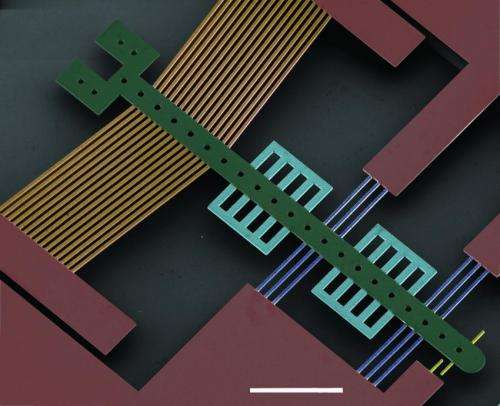Thin diamond films provide new material for micro-machines

(Phys.org) —Airbags, inkjet printers and video projectors may not seem to have much in common, but all three rely on the action of tiny, microscale devices in order to work properly.
These devices, known as microelectromechanical systems (MEMS), are of growing interest to researchers because of their wide range of applications, from microphones to biosensors.
Most of the current generation of MEMS are made primarily of silicon, which is due in large part to the relative ease of making silicon-based devices with current technology. However, silicon-based MEMS have a few significant drawbacks: they wear out very quickly due to friction and they are not biocompatible – preventing possible future medical applications within the human body.
Researchers at the Center for Nanoscale Materials at the U.S. Department of Energy's Argonne National Laboratory and a handful of other institutions around the world have directed their focus to exploring MEMS made of a relatively new material known as ultrananocrystalline diamond (UNCD), which are smooth and wear-resistant diamond thin films.
"Robust and reliable MEMS are needed for sliding and rotating actions on the small scale," Argonne nanoscientist Anirudha Sumant said. "Silicon does not have nearly as good mechanical or wear properties as diamond."
But the relative difficulty of trying to fashion a MEMS device from UNCD complicates matters. MEMS have to be made extremely precisely, and their components cannot shift out of place.
The goal of the experiment was to make the part of a MEMS device known as the actuator, which in this case converts heat energy into mechanical displacement or motion. The actuator looks like a web of diamond wires that expands and contracts like a bellows as it is heated and cooled. This web of diamond filaments is attached to a long shaft, which can then in turn be attached to a microgear system to provide rotational motion.
Unfortunately, the diamond material is beset by stresses that scientists need to find ways to work around. The material is especially notorious for what Sumant calls "compressive stress," a phenomenon that occurs because the diamond's atomic network does not expand that much during the hot phase when the film is deposited on another material. "The main question we're trying to solve is how to reduce the intrinsic stress in this film," Sumant said.
Fortunately, several of the properties of the UNCD film help to relieve the stress. UNCD consists of tiny diamond grains connected by grain boundaries. "You can think of these grain boundaries as a badminton net; they are flexible instead of rigid, which is good for accommodating stress," Sumant said. "There's also uniform grain size throughout from bottom to top, which is important for keeping the stress low."
The researchers were able to tune the intrinsic stress by optimizing the grain boundary materials and the thickness of the films.
"This really opens the door for using diamond for fabricating advanced MEMS devices," Sumant said.
A study based on the research, "Electrically conducting ultrananocrystalline diamond for the development of a next generation of micro-actuators," appeared in the May 2 issue of Sensors and Actuators A: Physical.
More information: Federico Buja, Anirudha V. Sumant, Jaap Kokorian, W. Merlijn van Spengen, "Electrically conducting ultrananocrystalline diamond for the development of a next generation of micro-actuators," Sensors and Actuators A: Physical, Volume 214, 1 August 2014, Pages 259-266, ISSN 0924-4247, dx.doi.org/10.1016/j.sna.2014.04.042.
Provided by Argonne National Laboratory


















